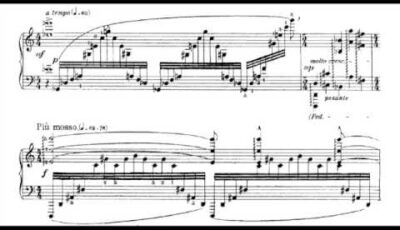-
Samuel Barber
…middle-class family in West Chester, Pennsylvania. His parents, Marguerite McLeod Beatty and physician Samuel Leroy Barber, nurtured a household that valued education and culture. While Barber’s father was a doctor,…
-
Béla Bartók
…attention of the renowned musician László Erkel, who then became Bartók’s teacher. Education and Early Musical Career (1899-1908) In 1899, Bartók began his professional studies at the Royal Hungarian Academy…
-
Bartok Rhapsody No. 1 for Violin and Piano – Performed by Josef Szigeti and Béla Bartok (1940)
Josef Szigeti and Béla Bartok perform Bartok’s Rhapsody n°1 for violin and piano in 1940….
-
Béla Bartók – Music for Strings, Percussion and Celesta, 4th Movement
Bartók’s “Music for Strings, Percussion and Celesta” was written in 1936 for conductor Paul Sacher. It showcases Bartók’s refined musical concepts and mastery. The piece effectively combines the piano with…
-
Bartok Music for Strings, Percussion & Celesta – 4th Movement
Bartok’s Music for Strings, Percussion & Celesta (Fricsay) IV is a fast and joyous movement that combines traditional classical structures. Influenced by Hungarian and Balkan folk music, Bartok showcases his…
-
Bartok Op. 18 Etudes for Piano
Bartok Op 18 Etudes – Bela Bartok’s 3 piano etudes were written in Rákoskeresztúr, Hungary in 1918. No 1 features disjunct chromaticism, tiring to play. No 2 has extended arpeggios…
-
Bela Bartok – Selections from Slovakian Children’s Songs on Classical Guitar
Emre Sabuncuoğlu, classical guitarist, performs his arrangement of Bela Bartok’s Slovakian Children’s Songs. Based on Slovakian folk tunes, Bartok, a Hungarian composer, was known for studying music from various cultures….
-
Béla Bartók – Music for Strings, Percussion and Celesta – 1st Movement
Béla Bartók’s “Music for Strings, Percussion and Celesta” was written in 1936 for conductor Paul Sacher. The piece consists of four movements: Andante tranquillo, Allegro, Adagio, and Allegro molto. Bartók…
-
Béla Bartók – Romanian Folk Dances No. 4, Sz. 56
Cubus plays Bartók’s Romanian Folk Dances No. 4, Sz. 56 – Mountain Horn Song. View playlist of all Bartók pieces by Cubus: https://www.youtube.com/playlist?list=PL317F248C65C01387…
-
Béla Bartók – Romanian Folk Dances No. 1
Cubus plays Stick Game from Romanian Folk Dances No. 1 by Béla Bartók. Check out the playlist of all Bartók’s pieces on YouTube: https://www.youtube.com/playlist?list=PL317F248C65C01387…
-
Béla Bartók – Music for Strings, Percussion, and Celesta – 2nd Movement
Béla Bartók’s Music for Strings, Percussion and Celesta was written in 1936 for Swiss conductor Paul Sacher. It showcases Bartók’s refined musical concepts, with the piano and percussion instruments effectively…
-
Bartok Music for Strings, Percussion & Celesta – Played by RIAS Symphony Orchestra
Bartok’s “Music For Strings, Percussion & Celesta” is a slow, dark masterpiece based on the fugue. The RIAS Symphony Orchestra, conducted by Bartok’s student Ferenc Fricsay, delivers an incredible performance….












